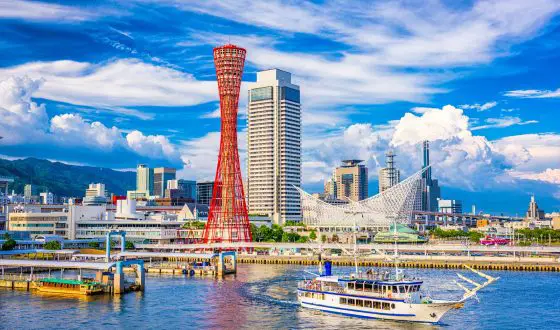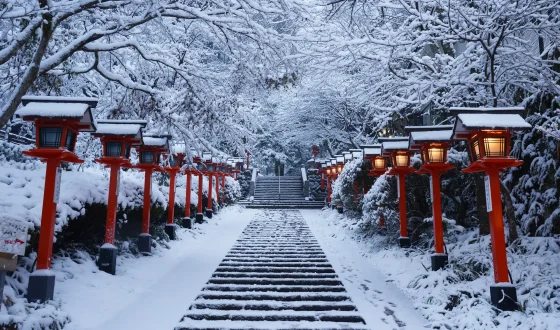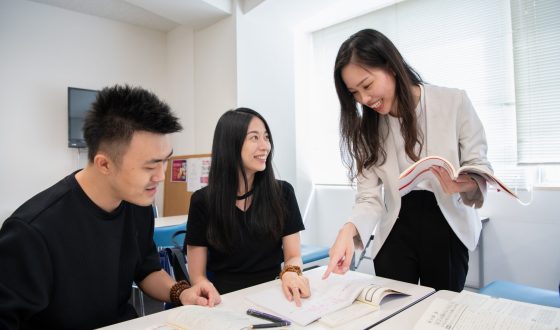Best sushi restaurants in Tokyo: Popular sushi situation among foreigners
There are many types of Japanese food, but sushi is by far the most popular among them and is eaten all over the world, including neighboring Asia, North and South America, and Europe. What kind of sushi toppings are preferred varies from country to country, but the trend is slightly different in Japan. Learn more about the best sushi restaurants in Tokyo and enjoy sushi more than ever before!
1. The best Sushi restaurants in Tokyo
1.1. Yuu Sushi「鮨由う」
1.1.1. Signature
In Roppongi, Sushi Yuu is silently present. The décor of the restaurant, which uses natural materials like wood and stone and has become a refined setting where taste and comfort continue to be cherished over time, was proposed by a designer who has worked in opulent inns and renowned Japanese restaurants. Enjoy the greatest sushi rated one star, together with our warm welcome.
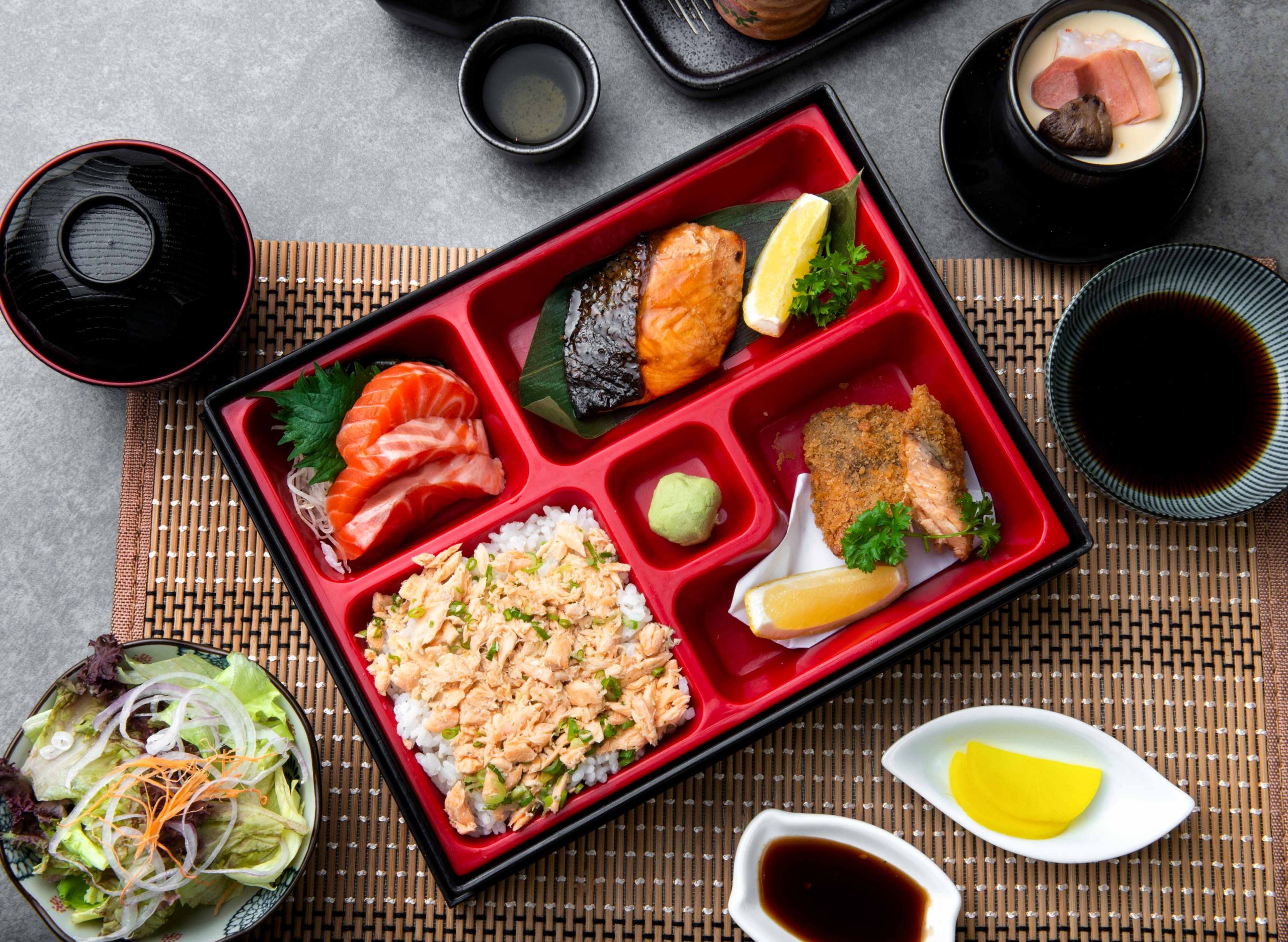
In Roppongi, Sushi Yuu is silently present. (Source: Internet)
1.1.2. Address
- 4-5-11 Land Roppongi Bldg. B1F, Roppongi, Minato
1.1.3. Business hours
- Saturdays: Lunch 12:00-14:00
- Weekdays and Saturdays: Dinner 17:30-23:00
1.1.4. Average budget
- Dinner: $172 (¥25000)
- Lunch: $137 (¥20000)
1.1.5. Equipment information
- Capacity: 12 people ( Seated at banquets and parties: 12 people )
- Parking: Yes, we do not have a parking lot, but there is a coin parking nearby.
1.1.6. How to get there
- A 4-minute walk from Exit 4a of Roppongi Station on the Tokyo Metro Hibiya Line, and a 3-minute walk from Exit 6 of Roppongi Station on the Toei Oedo Line.
1.1.7. Nearest station
- A 4-minute walk from Roppongi Station on the Tokyo Metro Hibiya Line
- A 3-minute walk from Roppongi Station on the Toei Oedo Line
1.2. Sushi Hatsune「初音鮨」
1.2.1. Signature
Hatsune Sushi is a small sushi restaurant located in Kamata, Tokyo. Founded in the 26th year of Meiji, they are devoted to serving our customers with delicious sushi. Every day, they purchase fresh ingredients from the fish market at Toyosu New Market and look forward to welcoming customers.
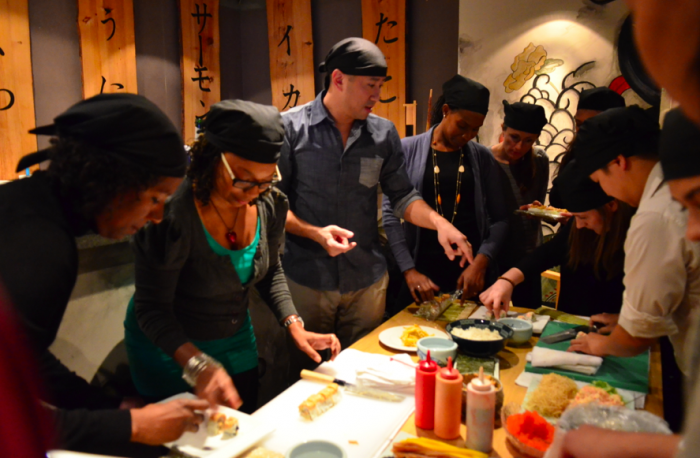
Hatsune Sushi is a small sushi restaurant located in Kamata, Tokyo. (Source: Internet)
They try not to use frozen products as much as possible. Please do not hesitate to ask us about your budget. Since it is in the Ueno district, you can feel the atmosphere of a downtown area. Currently, the 5th, 6th, and 7th generations are looking forward to your visit together with the store staff.
1.2.2. Address
- 5 Chome-20-2 Nishikamata, Ota City, Tokyo 144-0051, Japan
1.2.3. Business hours
- It will be a simultaneous start from 17:00
1.2.4. Average budget
- Dinner: $113 (From ¥16,500)
- Lunch: $416 (¥60,500)
1.2.5. Equipment information
- Capacity: 8 seats
- Parking: No parking
- Smoking permitted: No smoking
1.2.6. How to get there
- 5 minutes walk from JR Kamata Station West Exit
- 363m from Kamata Station
You can also like:
- 6 Types of Tuna for Sushi: Everything You Need to Know
- What To Serve With Sushi: The Delectable Side Dish Ideas
- Shabu Shabu and Hot Pot: Exploring the Differences and Delights of Asian Hot Pot Cuisine
1.2.7. Nearest station
- JR Line Kamata Station
1.3. UMI 「海味」
1.3.1 Signature
Umi is situated in the affluent Minami Aoyama neighborhood. One of the greatest, most reputable wholesalers in Otoyosu Market, Ishitsuka, provided fresh materials and carefully chosen vinegared rice. The menu at this restaurant offers seasonal meals made using a range of fresh seasonal ingredients.
You will enter a refined Japanese room once you have passed through the noren that exudes a Japanese vibe. The restaurant’s serene interior is spacious enough for the chef to view everything, which gives the area a feeling of cohesion.
Only the basic wood counter chairs are available, and they may be utilized for a variety of events including entertainment and supper. From these seats, you can watch the seafood being prepared in front of you.
1.3.2. Address
- 3-2-8 Minamiaoyama 1F, Minato 107-0062 Tokyo Prefecture
1.3.3. Business hours
- Lunch 12:00~
- From 17:00 to 23:00 at night
- *Lunch hours: Tuesdays, Fridays, Saturdays, and Sundays only
1.3.4. Average budget
- Dinner: $187 (¥27,280)
- Lunch: $263 (¥38,280)
1.3.5. Equipment information
- Capacity: 9 seats
- Parking: No parking
- Smoking permitted: No smoking
1.3.6. How to get there
- Subway Ginza Line Gaienmae Station Exit 1A 7 minutes on foot.
1.3.7 Nearest station
- Tokyo Metro Ginza Line Gaienmae Station
1.4. Kioicho Mitani「紀尾井町 三谷」
1.4.1. Signature
The supposedly hardest-to-reserve restaurant in the world, Miya in Yotsuya, debuted in 2016 as “Kioicho Mitani” on the third level of Tokyo Garden Terrace Kioicho.
The counter is formed of a single tree that originally functioned as the torii gate of Yasukuni Shrine and the finest chairs produced by the Imperial family’s chair artisans. There are only 12 counter seats and 1 private chamber for 4 to 6 people. Everywhere commitment is evident.
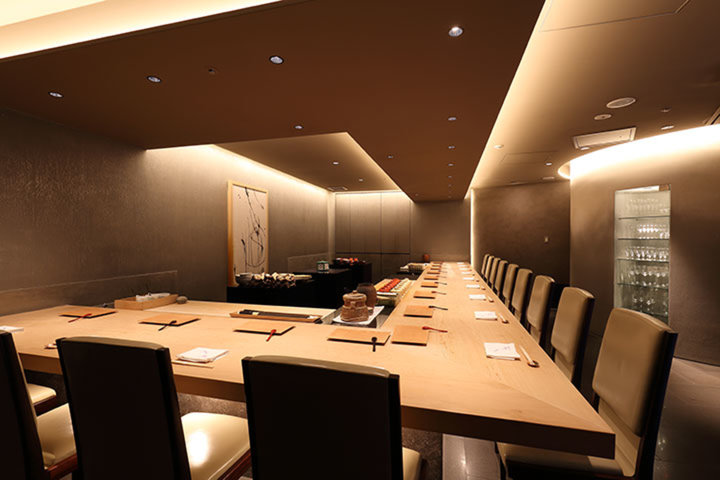
The supposedly hardest-to-reserve restaurant in the world, Miya in Yotsuya, debuted in 2016 as “Kioicho Mitani” on the third level of Tokyo Garden Terrace Kioicho. (Source: Internet)
The manner of “hand delivery” is another attribute that defines the one and only nigiri. Finding a fresh match is one of the delights of the broad range of sake that enhance the flavor of the nigiri. Please savor the best sushi in a luxurious setting.
1.4.2. Address
- 3rd floor of Kioicho Terrace
- Tokyo Garden Terrace Kioicho
- 1 Chome-3 Kioicho, Chiyoda City, Tokyo 102-0094
1.4.3. Business hours
- Lunch:12:00 a.m. 〜3:00 p.m.
- Dinner:5:00 p.m.〜10:30 p.m.
1.4.4. Average budget
- Dinner: $242 (¥35.200)
- Lunch: $242 (¥35.200)
1.4.5. Equipment information
- Capacity: 19 Seats, 1 private room available
- Parking: Yes Parking
- Smoking permitted: No smoking
1.4.6. How to get there
- Directly connected to Exit 9a of Nagatacho Station on the Tokyo Metro Hanzomon Line, Yurakucho Line, Namboku Line
- Tokyo Metro Ginza Line/Marunouchi Line Akasaka Mitsuke Station 3 minutes on foot
1.4.7. Nearest station
- Tokyo Metro Line Nagatacho Station
- Tokyo Metro Line Akasaka Mitsuke Station
1.5. Iwasawa Sushi「すし 岩澤」
1.5.1. Signature
The “Sushi Takumi” technique is carried over into the Omakase course at Sushi Iwasawa, which rotates between appetizers and nigiri. Three different varieties of sushi rice are utilized to produce the sushi elegantly and reliably, along with the season’s finest toppings.
Don’t miss the international hospitality that also offers customer service in English and Chinese for visitors from other countries. This restaurant has been visited by culinary enthusiasts for years, and in 2019 it received a Michelin star.
1.5.2. Address
- Japan, Tokyo, Shinagawa City, Nishigotanda, 5-chome-6-11
1.5.3. Business hours
- 17:30 ~ 23:00
- Closed: Wednesdays, Mondays of holidays, Thursdays of holidays
1.5.4. Average budget
- Dinner: $137~$206 (¥20,000~¥29,999)
1.5.5. Equipment information
- Capacity: 8 seats
- Parking: No parking
- Smoking permitted: No smoking
- Children: not allowed
1.5.6. How to get there
Access by public transportation:
- A 5-minute walk from Tokyu Meguro Line Fudomae Station
- A 9-minute walk from Exit A2 of Gotanda Station on the Tokyu Ikegami Line
- A 10-minute walk from the west exit of Gotanda Station on the JR Line
1.5.7. Nearest station
- Tokyu Meguro Line Fudomae Station
- Tokyu Ikegami Line Gotanda Station
- JR Line Gotanda Station
1.6. Ryusuke Sushi「鮨 竜介」
1.6.1. Signature
Sushi is made by the owner who trained at Kyubei for many years. Sushi Ryusuke only has 7 seats at the plain wood counter. It is a simple and calm space for adults. Please enjoy the “real taste of sushi” at your leisure in the “adult space” that is quietly set up in Ginza.
1.6.2. Address
- 7-3-13 Ginza, Chuo-ku, Tokyo Ginza Dai-4 Kanai Building B1F
1.6.3. Business hours
- Dinner: 18:00 – 22:30 (last entry at 20:30)
- Closed: Sundays and public holidays
1.6.4. Average budget
- Dinner: $250 (¥36,300)
1.6.5. Equipment information
- Capacity: 7 seats
- Parking: No parking
- Smoking permitted: No smoking
1.6.6. How to get there
- A 9-minute walk from Ginza Station on the Tokyo Metro Ginza Line, Marunouchi Line, and Hibiya Line
- 6-minute walk from JR Shimbashi Station
- 6-minute walk from Tokyo Metro Ginza Line Shimbashi Station
1.6.7. Nearest station
- Tokyo Metro Line Ginza Station
- JR Line Shimbashi Station
- Tokyo Metro Ginza Line Shimbashi Station
1.7. Osumojidokoro Uotoku「おすもじ処 うを徳」
1.7.1. Signature
You will feel as if you have slipped back in time as you pass through the Noren, which retains its old-fashioned atmosphere. A counter seat with a unique atmosphere and a beautiful contrast of a single cypress board.
The fresh seafood prepared there is put on special sushi rice blended with red vinegar and placed quietly in front of the customer. Please enjoy Edomae-style sushi at Uotoku which is luxurious yet comfortable.
1.7.2. Address
- 4-24-26 Higashimukojima, Sumida 131-0032, Tokyo Prefecture
1.7.3. Business hours
Tue ~ Fri: 18:00 ~ 23:00 (20:00)
Saturday: 17:30-23:00 (19:30)
Sunday:
- Lunch: 12:00-15:30 (13:00)
- Dinner: 18:00-22:00 (19:00)
Regular holiday: Monday
1.7.4. Average budget
- Dinner: $129 (¥18,700)
- Lunch: $129 (¥18,700)
1.7.5. Equipment information
- Capacity: 10 seats
- Parking: No parking
- Smoking permitted: No smoking
1.7.6. How to get there
- 5-minute walk from Higashi-Mukojima Station on the Tobu Isesaki Line
- 20 minutes walk from Keisei Oshiage Line Keisei Hikifune Station
1.7.7. Nearest station
- Tobu Isesaki Line Higashi-Mukojima Station
- Keisei Oshiage Line Keisei Hikifune Station
1.8. Edomaesushi Sushitsuu「江戸前鮓 すし通」
1.8.1. Signature
Edomaesushi Sushitsuu which is an 8-minute walk from Roppongi Station, is a hideout for adults. Here you can enjoy aged sushi, a gem of Japanese cuisine. The sushi made with great care is a masterpiece that you can enjoy with your eyes and your tongue. Please enjoy it to your heart’s content with delicious sake.
When you go down to the basement through the tasteful front curtain, you will be greeted by an elegant entrance like a Japanese garden with beautiful white gravel and stepping stones. The restaurant has a dignified air and is divided into semi-private rooms with comfortable sofa seats and counter-seats.
You can enjoy delicious aged sushi in a pure Japanese-style space with a beautiful white wood counter, indirect lighting using lattices, an ice room door in the center of the counter, and walls made of bamboo fences.
1.8.2. Address
- 3-1-15 RF Bldg. B1F, Nishiazabu, Minato 106-0031 Tokyo Prefecture
1.8.3. Business hours
- Lunch: 11:30-12:30 (12:00)
- Night: 18:00 – 22:30 (20:30)
- Closed: Sundays and public holidays
1.8.4. Average budget
- Dinner: $212 (¥30,800)
- Lunch: $114 (¥16,500)
1.8.5. Equipment information
- Capacity: 26 seats (3 semi-private rooms)
- Parking: No parking
- Smoking permitted: No smoking
1.8.6. How to get there
- An 8-minute walk from Exit 1c of Roppongi Station on the Tokyo Metro Hibiya Line
- 8-minute walk from Exit 1c of Roppongi Station on the Toei Oedo Line
1.8.7. Nearest station
- Tokyo Metro Hibiya Line Roppongi Station
- Toei Oedo Line Roppongi Station
1.9. Asakusa Juroku「浅草じゅうろく」
1.9.1 Signature
An up-and-coming soba restaurant “Asakusa Juroku” was born in Asakusa. This is a “Soba-mae” restaurant that creates a new era, where you can enjoy dishes made with seasonal ingredients procured daily from Tsukiji Market and Nihachi soba noodles made by the proprietress along with Japanese sake.
A small shop with 2 counters (8 seats) and 2 table private rooms (5 seats). It is a restaurant where you can enjoy casually with friends while communicating with the owner and proprietress. For children, a la carte service is available upon request at the time of booking. Available in various scenes.
1.9.2. Address
- 1st Floor Odai Building 4-37-8 Asakusa, Taito-ku, Tokyo, Japan
1.9.3. Business hours
- 18:00 ~ 23:00
- Regular holiday: Monday
1.9.4. Average budget
- Dinner: $96 (¥14,000)
1.9.5. Equipment information
- Capacity: 18 seats
- Parking: No parking
- Smoking permitted: No smoking
1.9.6. How to get there
- About 8 minutes on foot from Asakusa Station on the Tsukuba Express Line
1.9.7. Nearest station
- Tsukuba Express Line Asakusa Station
- Ginza Line Asakusa Station
1.10. Ishijima Sushi「鮨石島」
1.10.1 Signature
Feel free to enjoy the real skill without being pretentious. This restaurant of goal is to bring out the true flavor of carefully selected ingredients with reliable technology.
The bamboo ceiling creates an even more Japanese atmosphere in the restaurant, where the sound of wind chimes resounds. The fresh flowers that make you feel the season in Japanese taste are the work of the host. The shop has a Japanese atmosphere with wind chimes and fresh flowers. Please spend a relaxing time in a relaxing space.
1.10.2. Address
- 1-24-3 Ginza, Chuo-ku, Tokyo
1.10.3. Business hours
Mon-Fri:
11:30-14:00
18:00-23:00 (L.O.22:30)
Saturday: 17:30-22:30
Closed: Saturdays (first and third days of each month), Sundays, and public holidays
1.10.4. Average budget
- Dinner: $227 (¥33,000)
- Lunch: $45 (¥6,600)
1.10.5. Equipment information
- Capacity: 14 seats (1 private room)
- Parking: No parking
- Smoking permitted: No smoking
1.10.6. How to get there
- A 3-minute walk from Shintomicho Station on the Tokyo Metro Yurakucho Line
1.10.7. Nearest station
- Tokyo Metro Yurakucho Line Shintomicho Station
1.11. Takumi Makoto「匠 誠」
1.11.1. Signature
Takumi Makoto has inherited the techniques cultivated at the famous sushi restaurant “Sushi Sho” and offers bite-sized nigiri and side dishes alternately in a refreshing style. Carefully and meticulously prepared toppings, exquisite sushi rice, and original appetizers prepared by the experienced chef.
It is in a great location, just a minute’s walk from Shinjuku Station. There are only 9 counter seats in the store. A space where the Japanese beauty of eating sushi stands out. In front of the neat counter, the master’s craftsmanship unfolds, and you can enjoy conversation about sushi ingredients. Please enjoy the best sushi with important moments on dates and anniversaries.
1.11.2. Address
- 4-1-9 Shinjuku Shinjuku Youth Bldg. PAX 6F, Shinjuku 160-0022 Tokyo Prefecture
1.11.3. Business hours
Mon/Wed/Fri: 18:00-23:00
Tue/Thu/Sat:
- Lunch 11:30 – 13:30
- Dinner 18:00 – 23:00
Closed: Sundays and Mondays of public holidays
1.11.4. Average budget
- Dinner: $172 (¥25,000)
1.11.5. Equipment information
- Capacity: 9 seats
- Parking: No parking
- Smoking permitted: No smoking
1.11.6. How to get there
- A 1-minute walk from the southeast exit or Miraina Tower exit of Shinjuku Station on the JR Line
1.11.7. Nearest station
- JR Line Shinjuku Station
1.12. Susidokoro Ginzahokake「寿司処 銀座ほかけ」
1.12.1. Signature
Needless to say, Hokake is a well-known Edomae sushi restaurant along Showa-dori, close to Kabukiza Theater in Ginza. Passing through the noren curtain that sways in the breeze, the head chef welcomes guests from a counter made of a single piece of Kiso cypress. Nigiri is based on old-fashioned taste, where you can enjoy as much as you like.
Large nigiri sushi, which is the true value of this restaurant, is delivered from the chef’s palm at a good tempo. Founded in 1937. This is a place where you can’t help but be fascinated by the genuine work that hasn’t changed since before the war.
Inside the store, the old store was built by a shrine carpenter in 1952, such as the counter made of a single piece of Kiso cypress, the eaves, and the roof. In addition to the swaying eaves, behind the short noren curtain with a boat drawn on it, you can enjoy the appearance of the chef, who continues to earnestly face sushi, and the elegance of Edomae that does not change with the passage of time.
1.12.2. Address
- Ginza Building 1F, 4-10-6 Ginza, Chuo-ku, Tokyo
1.12.3. Business hours
- Lunch: 11:30-14:00 (13:30)
- Dinner: 16:30-21:00 (20:00)
Closed: Sundays, national holidays, third Saturdays
1.12.4. Average budget
- Dinner: $208 (¥30,250)
- Lunch: $45 (¥6,600)
1.12.5. Equipment information
- Capacity: 9 seats
- Parking: No parking
- Smoking permitted: No smoking
1.12.6. How to get there
- A 1-minute walk from Exit A2 of Higashi-Ginza Station on the Tokyo Metro Hibiya Line
- A 1-minute walk from Exit A2 of Higashi-Ginza Station on the Toei Subway Asakusa Line
1.12.7. Nearest station
- Tokyo Metro Hibiya Line Higashiginza Station
- Toei Subway Asakusa Line Higashi Ginza Station
1.13. Zouroku Yuuzan Honten「蔵六雄山(本店)」
1.13.1. Signature
A 3-minute walk from Roppongi Station, you can enjoy the finest sushi and a wide variety of Japanese sake at Kuraroku Yuzan in an adult town with beautiful glittering neon lights.
When you step into the store, which combines quality and comfort, you will be greeted by a neat counter seat that stretches to the back. The omakase course, where the owner’s commitment and skill shine, is a delightful style where you can alternately enjoy sushi and side dishes that make the most of the season.
Zouroku Yuzan (main branch) has a beautiful plain wood counter that surrounds the board. You can feel the Japanese taste from the round window, the lighting using shoji, and the ice room with the wooden door.
From the spacious counter seats, you can enjoy not only the taste but also the eyes, as you can see the beautifully arranged seafood box along with the owner’s splendid handling. Enjoy the finest sushi and sake in a relaxing moment.
1.13.2. Address
- 7-18-24 Roppongi, Suzuki Building 2F, Minato-ku, Tokyo
1.13.3. Business hours
- Monday~Friday, the day before a holiday: 18:00-23:00 (Last entry 21:00)
- Saturday: 18:00-22:00 (Last entry 19:30)
- Closed: Sundays and public holidays
1.13.4. Average budget
- Dinner: $227 (¥33,000)
1.13.5. Equipment information
- Capacity: 14 seats
- Parking: No parking
- Smoking permitted: No smoking
1.13.6. How to get there
- A 3-minute walk from Exit 2 of Roppongi Station on the Tokyo Metro Hibiya Line
- A 3-minute walk from Exit 2 at Roppongi Station on the Toei Oedo Line
1.13.7. Nearest station
- Tokyo Metro Hibiya Line Roppongi Station
- Toei Oedo Line Roppongi Station
1.14. Takuhiro Takumi「匠 達広」
1.14.1. Signature
Inheriting the tradition of the famous sushi restaurant Yotsuya Sushisho, you can enjoy the omakase that alternately offers carefully crafted appetizers and nigiri sushi. The seafood used is not only from Tsukiji, but also directly delivered from Hokkaido, Kyushu, and Ishikawa.
The beautiful white wood counter is designed so that every seat is under the watchful eye of the craftsman. You can enjoy the toppings arranged in front of you and the skill of the craftsman who makes them. We also have a private room that can accommodate up to 6 people, so it is also recommended for important entertainment.
1.14.2. Address
- 1-11-7 Shinjuku Sunsara No.5 Gyoen Bldg. 1F, Shinjuku 160-0022 Tokyo Prefecture
1.14.3. Business hours
- Lunch: 11:30-14:00 (Last entry 13:00)
- Dinner: 16:00-22:00 (Last entry 20:00)
Closed: Sundays and Mondays of public holidays
1.14.4. Average budget
- Dinner: $189 (¥27,500)
- Lunch: $60 (¥8,800)
1.14.5. Equipment information
- Capacity: 18 seats (1 private room)
- Parking: No parking
- Smoking permitted: No smoking
1.14.6. How to get there
- A 3-minute walk from Exit 2 of Shinjuku Gyoenmae Station on the Tokyo Metro Marunouchi Line
1.14.7. Nearest station
- Tokyo Metro Line Shinjuku Gyoenmae Station
1.15. Sushi Ginza Onodera「鮨 銀座おのでら」
1.15.1. Signature
The New York store, which opened in May 2016, received one star in 2017 and two stars in 2018 from the New York version of the famous restaurant guide. Also, in 2018, at the last auction of the Tsukiji market at the beginning of the year, I won the highest price (Ichiban tuna).
In order to deliver the “genuine” of Japan to customers around the world, “craftsmen with the best skills” in “Japan’s finest ingredients” and “hospitality dining space” for each person ” Ginza Onodera promises an unforgettable time.
The interior of the restaurant is reminiscent of a hideaway away from the hustle and bustle, and the counter is made of Ise cypress, which is synonymous with Onodera. In addition to the interior, by using Bizen ware, Edo Kiriko, Baccarat, Arita ware, and Kiyomizu ware for the tableware, you can enjoy the tasteful harmony with the masterpieces created by the head chef, Sakaue, from the ingredients to the details. You can enjoy seasonal designs from chopsticks, coasters, and lap blankets.
1.15.2. Address
- 5-14-14 Ginza, Chuo-ku, Tokyo Sunlit Ginza BuildingⅢ B1F ・ 2F
1.15.3. Business hours
- Lunch: 11:00-15:00 (14:00)
- Dinner: 17:00 – 22:30 (21:00)
- Closed: Year-end and New Year holidays only
1.15.4. Average budget
- Dinner: $208 (¥30,250)
- Lunch: $61 (¥8,800)
1.15.5. Equipment information
- Capacity: 9 seats
- Parking: No parking
- Smoking permitted: No smoking
1.15.6. How to get there
- A 1-minute walk from Exit 4 of Higashi-Ginza Station on the Tokyo Metro Hibiya Line
- A 1-minute walk from Exit 4 of Higashi Ginza Station on the Toei Subway Asakusa Line
- A 4-minute walk from Exit A5 of Ginza Station on the Tokyo Metro Ginza Line, Marunouchi Line, and Hibiya Line
- A 5-minute walk from Exit A3 of Tsukijishijo Station on the Toei Oedo Line
- A 10-minute walk from JR Line Yurakucho Station
1.15.7. Nearest station
- Tokyo Metro Hibiya Line Higashiginza Station
- Toei Subway Asakusa Line Higashi Ginza Station
- Tokyo Metro Line Ginza Station
2. Overseas sushi situation
2.1. International variations in sushi presentation
The popularity of sushi is widespread, but it is growing every year, and there are currently many different varieties of it. In addition to sushi restaurants with a focus on sushi, sushi on a conveyor belt, which was previously solely available in Japan, is now available internationally.
Due to its integration into local culture, sales models have evolved recently, including sushi delivery services and delicatessen sections in supermarkets.
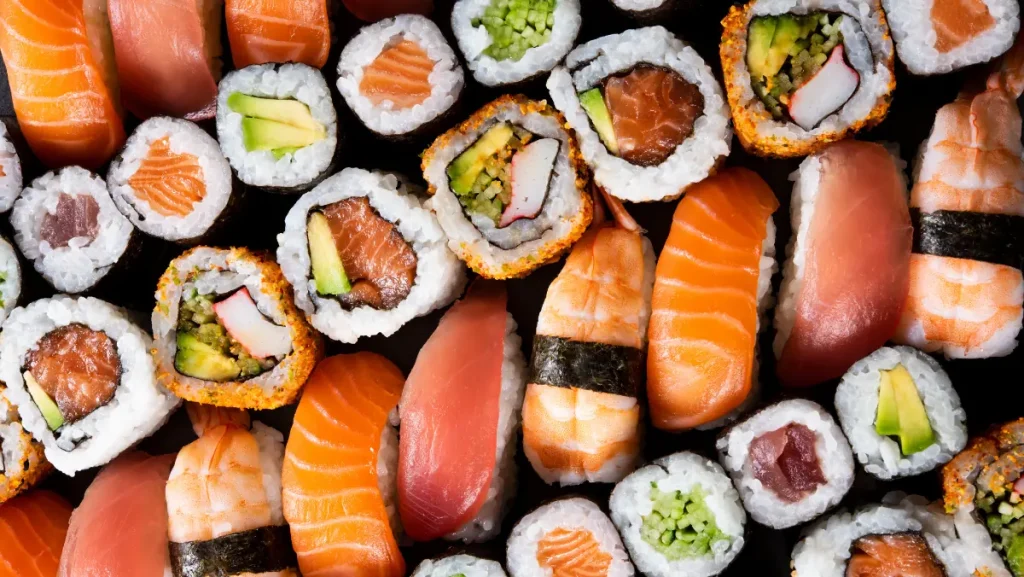
The popularity of sushi is widespread, but it is growing every year, and there are currently many different varieties of it. (Source: Internet)
Additionally, there are a growing number of sushi places. Sushi is already as popular as fast food, for instance, and French brands like “Sushi Shop” have the same number of locations as large hamburger franchises.
Here are more than 1,500! You can tell that sushi is popular across the world just by glancing at this number!
2.2. Creative sushi and colorful sushi
Nigirizushi is also consumed outside of Japan, but the vast majority of inventive sushi that isn’t nigiri is typical of sushi served outside of Japan.
The United States and Europe both clearly show this tendency. It is now considered a minor French dish in France. Sushi comes in a vast variety in South American countries like Brazil and Chile, including deep-fried sushi that is bread crumb-coated.
On the other hand, East Asian nations that are near Japan, such as China, Taiwan, and South Korea, are distinguished by being somewhat similar to Japan. Additionally, the proportion of inventive sushi, such as sushi rolls, is growing in Southeast Asia countries like Indonesia and Vietnam, and the colors are steadily getting more vibrant.
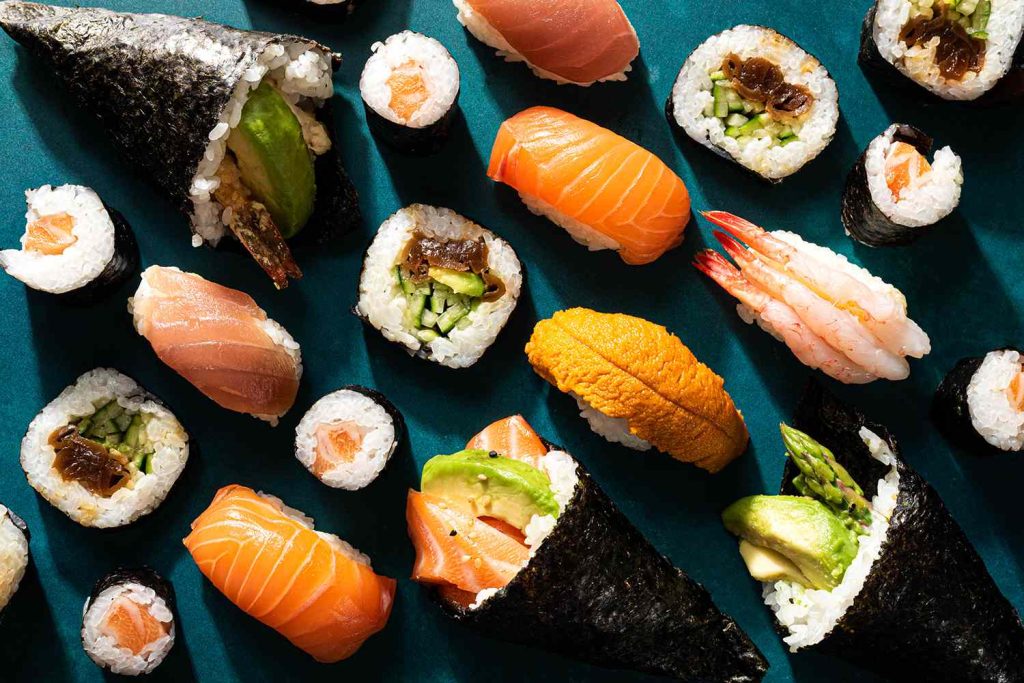
Nigirizushi is also consumed outside of Japan, but the vast majority of inventive sushi that isn’t nigiri is typical of sushi served outside of Japan. (Source: Internet)
Given that Japan also developed a broad range of sushi in each location, it is particularly intriguing that this is occurring on a worldwide scale. It is eaten in a highly original way that meets the taste preferences of each nation. It’s a predicament.
3. Types of sushi ingredients that foreigners like to eat
Let’s now look at the most well-liked sushi toppings abroad in a rating structure!
3.1. Salmon
Many nations, including the United States, Russia, China, Taiwan, Vietnam, Brazil, and France, are big consumers of salmon. It doesn’t smell fishy, making it simple to consume, and people appear to like it for its rich, sweet flavor and fat on top. In addition to being utilized for nigiri sushi, it is also a component of the globally renowned rolled sushi.
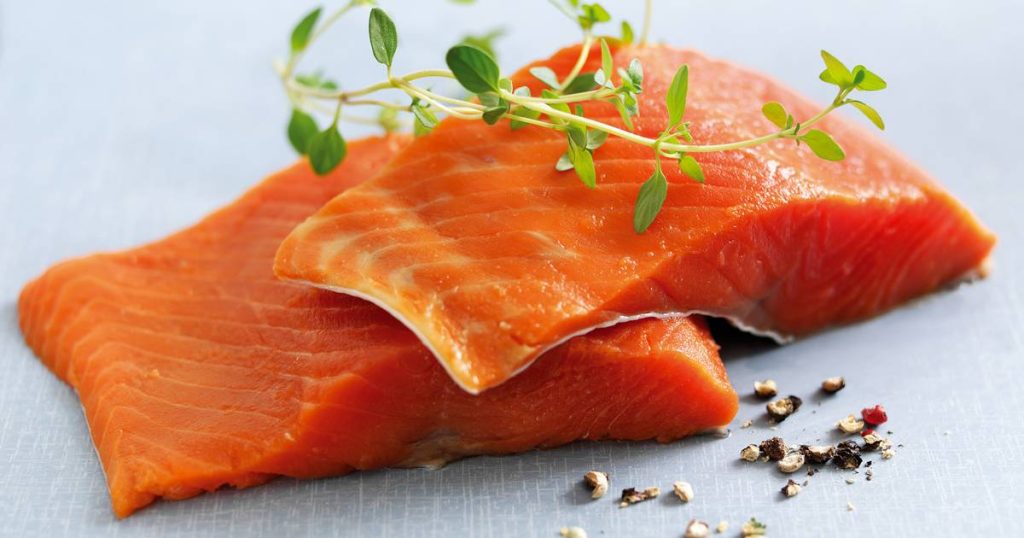
It doesn’t smell fishy, making it simple to consume, and people appear to like it for its rich, sweet flavor and fat on top. (Source: Internet)
3.2. Sushi roll (inside rolled sushi)
Overseas, uramaki sushi is known as a sushi roll, and particularly in Western nations, sushi rolls are sometimes mistaken for nigiri sushi.
In essence, the look is flamboyant and colorful, and it is sometimes embellished with sesame seeds and vividly colored tobiko. The inside is frequently made up of mayonnaise, cheese, and avocado.
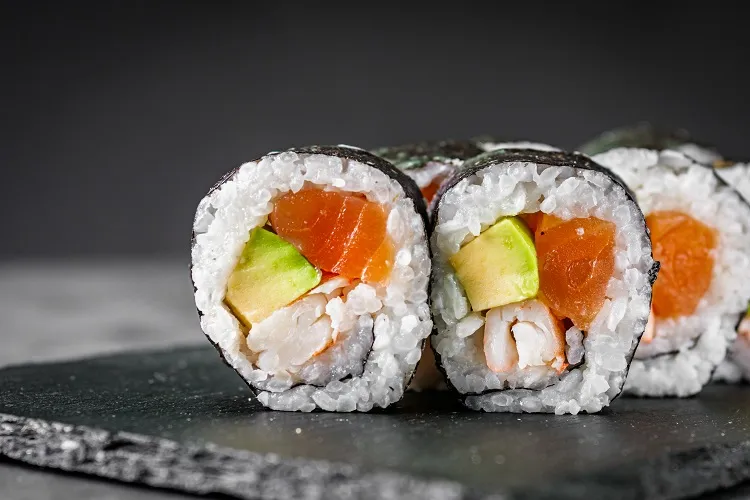
Overseas, uramaki sushi is known as a sushi roll, and particularly in Western nations, sushi rolls are sometimes mistaken for nigiri sushi. (Source: Internet)
It is particularly well-liked in Western and South American nations like Germany, the United States, Italy, Chile, and Chile, where people often loathe raw foods and seaweed.
3.3. Tuna
After salmon, tuna is the most popular nigiri sushi. Chutoro and Otoro, which are both fatty and flavorful and familiar to Japanese people, appear to be more well-liked than red meat.
It holds a particular place as a high-end sushi component and is more well-liked in Asia, including China, Taiwan, South Korea, and Vietnam, than it is in Europe and the United States, including France and the United States.
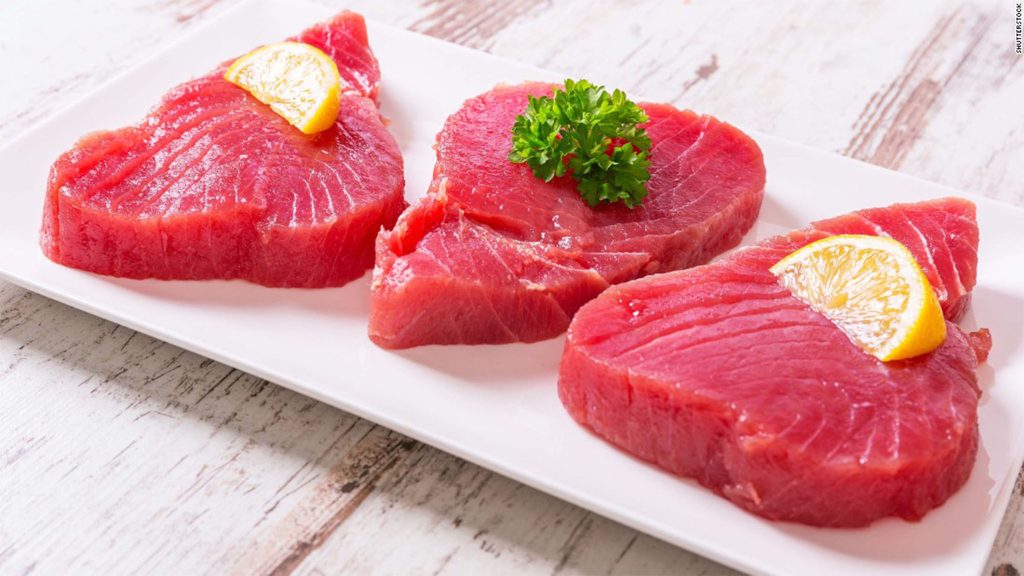
After salmon, tuna is the most popular nigiri sushi. (Source: Internet)
3.4. Shrimp
Many nations, including Thailand and Vietnam, where shrimp fishing is growing, and the United States, and France all consume shrimp.
While steamed shrimp is more commonplace than raw shrimp in the United States and France, where the habit of eating raw food is relatively low, raw shrimp and red shrimp are also popular in Japan. Popular sushi arrangements include steamed shrimp, avocado, and mayonnaise.
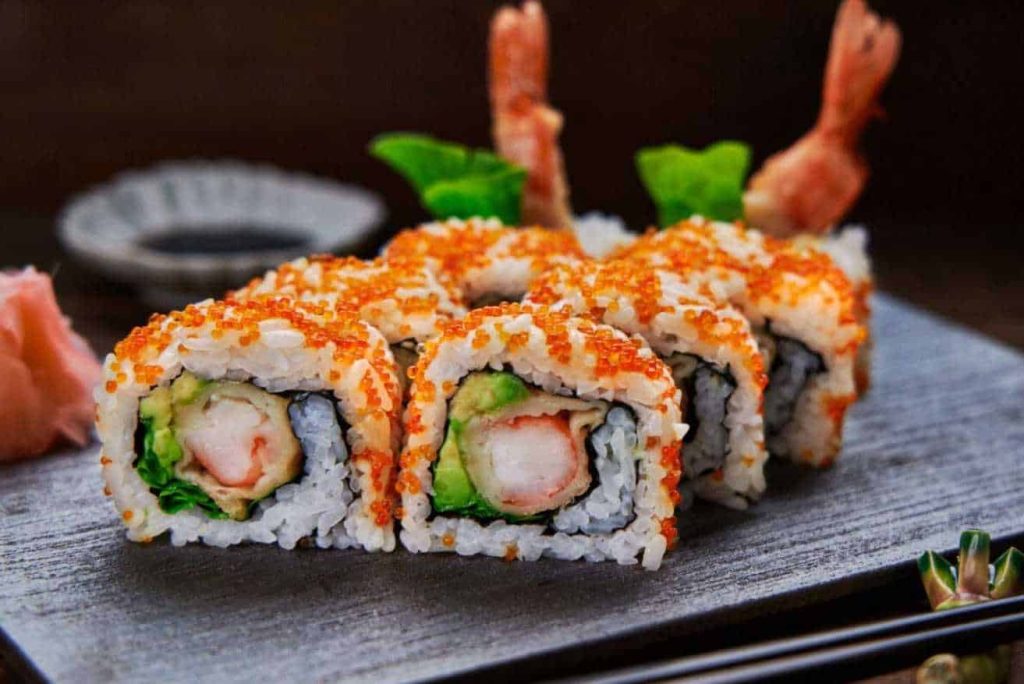
Many nations, including Thailand and Vietnam, where shrimp fishing is growing, and the United States, and France all consume shrimp. (Source: Internet)
In Asia, there aren’t many Westerners who enjoy shrimp, but when Western nations are taken into account, shrimp takes the top spot as a sushi element.
3.5. Salmon Roe
Ikura is one of the most well-liked sushi toppings outside of Japan because of its exquisite beauty and delectable flavor.
Salmon roe is another common component of sushi in France, a country where caviar and other fish roe are popular. Salmon is the parent fish, thus it would appear that there is a way to refer to it as caviar as well.
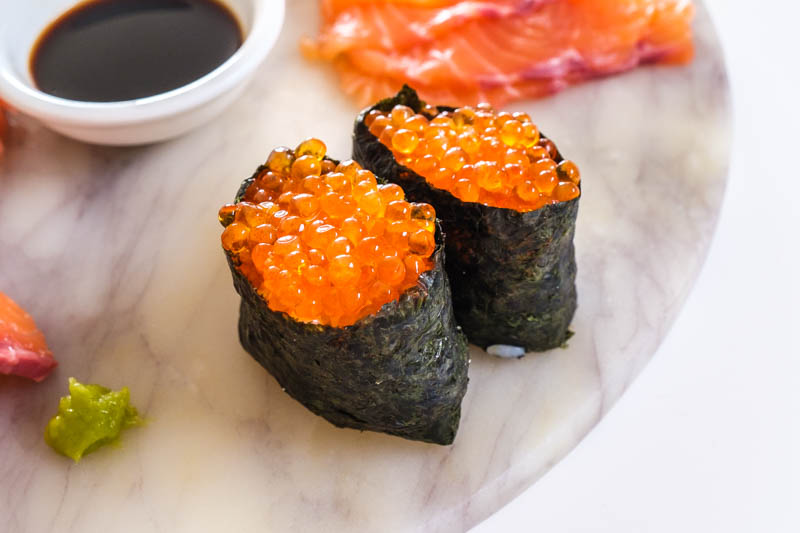
Salmon roe is another common component of sushi in France, a country where caviar and other fish roe are popular. (Source: Internet)
Fish roe, however, tends to be avoided in various regions of Northern Europe and North America, and it appears to be a contentious issue. By the way, salmon roe is a common sushi ingredient in Russia as well because the phrase salmon roe is Russian in origin.
4. FAQs
4.1. What do you order sushi from?
How to eat sushi correctly and deliciously? The order starts with the white fish first. White-fleshed fish such as sea bream and flounder have a bland taste, so if you eat them after the fatty tuna or yellowtail, or the strongly flavored conger eel, the impression will be vague, so order it first.
It’s a bit off the beaten path, but some people know that when they enter a sushi restaurant, the first thing they do is eat tamagoyaki.
4.2. What are your top 10 sushi toppings?
We will introduce the features and appeal of the top 10 sushi toppings.
- 1st place: Tuna (medium fatty tuna)
- 2nd place: Salmon
- 3rd place: Tuna (red meat)
- 4th place: yellowtail
- 5th place: Fatty salmon
- 6th place: Negitoro
- 7th place: Ikura
- Tie 8th: Shrimp
4.3. In what order do you eat sushi before eating it alone?
Recommended ordering method. Also, if you remember this “one serving”, it will be helpful to order as you wish. The order of preference is written “as much as you like, in the order you like”, but the order ‘from light to dark, then sweet to roll” is also one of the basic patterns.
4.4. Is it polite to eat sushi with your hands?
Many people think that it is good manners to eat sushi with your hands, but in reality, you can eat it with your hands or with chopsticks. Eating with your hands keeps the sushi rice from falling apart, and eating with chopsticks keeps the temperature of the toppings from changing.
4.5. What kind of sushi do Japanese people like the most?
“Salmon” came in first place. After the second place, “tuna” and “shrimp” followed, and “octopus” and “scallops” were tied for seventh place.
4.6. What happens if you eat two bites of sushi?
Eat in two bites? In order to eat beautifully, nigiri sushi should be eaten in one bite. If you can’t eat it in one bite, cut it in two with chopsticks and eat it in half. If possible, it would be better to order “Please make the shari smaller” when ordering.
4.7. Do you lay your sushi on its side to eat?
You can eat nigiri with chopsticks or with your hands. The important thing is to enjoy the balance between toppings and sushi rice in your mouth. By laying the sushi on its side and placing it on your tongue, you can enjoy both the toppings and the sushi rice at the same time. Of course, nigiri is eaten in one bite.
4.8. Who was the first person to eat sushi?
The inventor is unknown, but it is believed that Yohei Hanaya, the owner of “Yohei Sushi”, was the first to complete it. At that time, “nigirizushi” consisted of sushi rice seasoned with vinegar and salt, with seeds prepared from fish and shellfish caught in Edomae. It seems that.
4.9. Do you eat sushi with your hands or chopsticks?
In terms of manners, it doesn’t really matter. However, you can enjoy the sushi even more if you eat it directly with your hands, as you can feel the softness of the sushi. In addition, it is better to order the light-flavored ones first, followed by the strong-flavored or fatty ones.
Conclusion
Shinjuku is not only Tokyo’s representative entertainment district but also the best sushi restaurant in Tokyo. Many foreigners also visit Shinjuku because there are many spots popular with foreigners. At that time, if you can taste delicious sushi, you can have a deeper taste of Japan. Please try it by all means.

